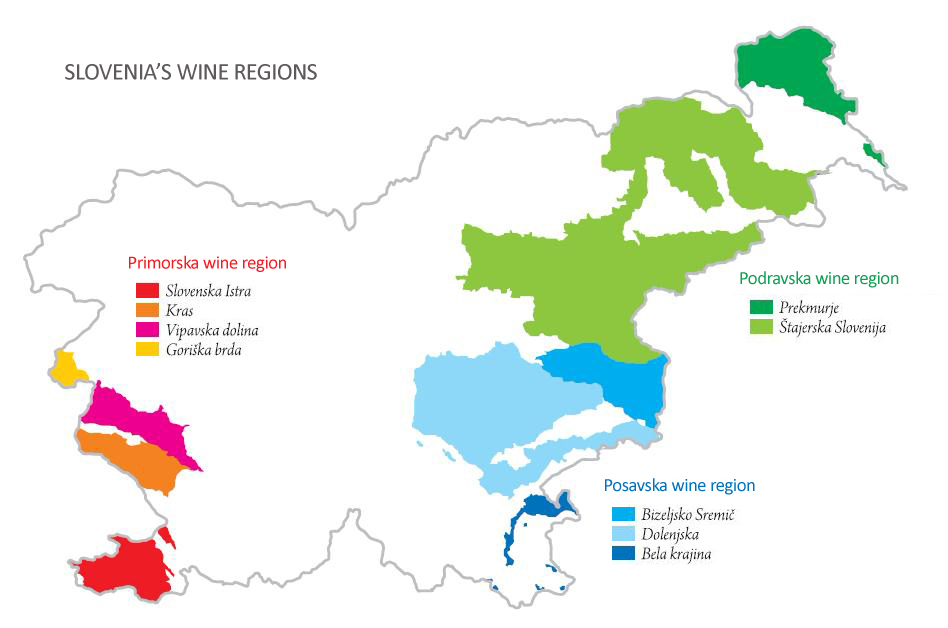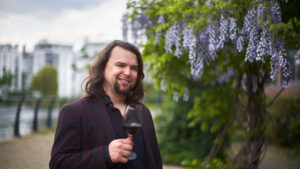For this year’s Meininger’s Forum Vini, Orbico Adriatic Wines invited me to hold two masterclasses: one on the Wines of Slovenia and another to explore Croatian terroir. In November, approximately 100 wine stands and thousands of visitors passed through the gates of the fair in Munich. The masterclasses were held in the so called “Klassenzimmer”, highlighted six wines from different wineries, representing diverse styles of viticulture and winemaking. In this Article, we will be exploring the Slovenian heritage and their wines.
The Roots of Slovenian Viticulture
Slovenia’s viticultural history is deeply rooted in the past, with vine cultivation dating back to pre-Roman times. The Romans then introduced their winemaking expertise to the region. Significant development occurred in the Middle Ages with the establishment of monastic vineyards, and later, the Habsburg dynasty promoted the quality and export of the wines. This rich heritage has resulted in a landscape with over 28,000 winegrowers who nurture a production that exceeds 80 million liters annually. Overall, Slovenia produces less than 1% of the EU’s wine output, making it truly niche.

The Soul of Slovenian Wines
The unique interplay between the Alpine, Mediterranean, and Pannonian climates provides Slovenia with three distinct wine regions, each with its signature offerings:
Primorska: Blessed by the Adriatic Sea, Primorska enjoys a Mediterranean climate ideal for growing a variety of grape types. The region is renowned for its white wines, especially Rebula, characterized by a medley of citrus and herbal notes.
Podravje: Between continental breezes, Podravje is a haven for red grape varieties. Thermal springs and mineral-rich soils foster an environment conducive to producing robust reds like Merlot and Blaufränkisch. Welschriesling, Sauvignon, Riesling, Chardonnay, Furmint, and Yellow Muscat are also common.
The Sub-region Štajerska Slovenija is the 2nd largest wine-growing region in Slovenia, which is held by Prekmurje in the north. It is a very varied landscape with steep slopes in Haloze, distinctly anthropogenic terraces in Ljutomersko-Ormoška gorice and Maribor, which can boast of a vineyard in the middle of the city and the oldest vine in the world – zametovka or blue sofa, which has been delighting wine lovers for more than four centuries . In the northern part, the hills end with the Radgonska-Kapelski mountains, which descend towards Prekmurje into the Pannonian plain.
The surroundings have already known locations from the past, which are ranked among four percent of the best wine-growing locations in the world. The soil developed on soft carbonate rocks. Although until recently, mostly semi-dry wines came from the Styrian area, today winemakers are betting on fresh dry wines, and the flagship is predicates.
Posavje: Known for the harmonious Cviček, a blend of red and white grapes, Posavje is a region where tradition defies convention. Remarkably, the grapes used are typically for sparkling wine production, accentuating its freshness and light body. This was one of my personal discoveries this year!
Diverse Flavors
The treasure of Slovenian wines lie in their diversity. While international grape varieties take on a unique character in Slovenia, it is the indigenous varieties that truly embody the nation’s vinous identity:
Rebula: Known in Italy as Ribolla Gialla, this grape captures the sunlight of Primorska in wines with a fresh, mineral essence and a light, chalky tannic texture. It is commonly used for orange wine production.
Furmint: Locally known as Šipon, this variety produces wines that balance sweetness with lively acidity, mirroring the complexity of Podravje’s terroir.
Žametna Črnina: Indigenous to Posavje, this red variety yields wines with a soulful purple hue and an aroma of dark berries. It is one of the key varieties for Cviček.
The Renaissance of Orange Wines
Slovenia is at the forefront of the orange wine revival. By allowing white grapes to macerate with their skins from a few hours to several weeks, Slovenian winemakers are using an ancient technique to create intricate wines with layered notes of citrus, stone fruits, and a subtle tannic structure that defies traditional white winemaking practices.
An Invitation to Indulge
To truly understand Slovenian wine, one must experience it firsthand. Attendees of our masterclass journeyed through the varied wine regions of Slovenia, familiarizing themselves with the subtle distinctions that make each area’s output unique. Having been in the wine trade for over 13 years and mainly encountering only a handful of wineries, I am excited to delve more deeply into the wines of these countries in the future.
Our Tasting:
Zlati Grič Pinot Gris 2022

The Pinot Gris reveals a bright yellow color, hinting at its rich floral nuances. A cold maceration technique brings forward a crisp palate teeming with lime, apple, and subtle bitter almond notes. In harmony, the acidity and residual sugars forge a robust yet balanced profile, leading to a moderate finish that is both refreshing and complex.
Ducal Winery, Beli Pinot 2021 (Pinot Blanc)

This orange wine from the terroir of Štajerska Slovenija is one to remember. Its winemaking process favors natural yeast fermentation and a lengthy maturation on the skins, split between concrete eggs and stainless steel, which releases the pure expression of the grape. On the nose, it unfolds delicate notes of orchard fruits, such as apple and pear, while the palate is greeted with a smooth, leesy texture. The wine’s structure is underpinned by crisp acidity that dovetails beautifully with a subtle, briny minerality, ensuring lingering freshness and a persistent finish. This is a highly gastronomic wine that pairs well with creamy dishes or white meats. Bravo!
Zlati Grič Riesling 2020

The Riesling offers an off-dry profile from Štajerska Slovenija with a strikingly high, searing acidity that is harmoniously counteracted by residual sugar. It delivers a moderate body and intensity, with succulent peach and pear notes underscored by herbal nuances. This well-structured and approachable wine draws a pleasant parallel to a Mosel Riesling.
Ducal Winery Riesling 2019

A masterful expression of terroir, this Riesling underwent warm skin maceration for 12 days and spontaneous fermentation. It then aged 18 months in used oak barrels, remaining unfiltered and unclarified. The wine exhibits herbaceous notes alongside a soft petrol touch (TDN), creating a robust yet balanced profile. Its high, vibrant acidity and mineral streaks culminate in a distinct salty freshness and a lingering, leesy finish. This gastronomic wine, nearly challenging, pairs excellently with pork, veal, poultry, selected cheeses, cured meats, and grains. It also complements sushi and Thai curries beautifully.
Winery Krško Cviček Premium 2023

The 2023 vintage, specially bottled for the fair, is Cviček at its finest. With a modest 10% ABV, it boasts a light body and delicate flavors of raspberries, cherries, and subtle hints of red plums. While it may not be the most complex, it excels in drinkability and smoothness. As the Slovenians would say, it’s suitable for sipping throughout the day on any occasion.
The wine is a harmonious blend of native and international grape varieties, including Žametna Črnina, Blaufränkisch, Kraljevina, Welschriesling, and Rumeni Plavec. It is crafted through a meticulous process involving 24-48 hours of cold maceration, followed by fermentation at lower temperatures in stainless steel tanks, and then filtration. As Slovenia’s “national wine,” Cviček carries historical significance and stands as a popular choice among the people.
Blaufränkisch Turn Classic 2020

A classic Blaufränkisch that offers a fruit-driven and lightly herbal expression. It has moderate intensity and complexity, with well-balanced fresh acidity and light, silky tannins. The wine underwent a 10-day cold maceration period and temperature-controlled, cool fermentation in stainless steel tanks, followed by filtration. It is easy to drink and pleasurable. I agree with the 90 Falstaff Points it received.
Thanks for Reading!
Glad you dropped by! If the insights here struck a chord, why not share them? And if you’re eager to talk more, I’m all ears – just reach out. Looking for someone to spark inspiration in your masterclass or brand event? Let’s talk and set up something amazing.
Disclaimer
This text was neither commissioned nor compensated. It reflects exclusively my own opinion.

ConVINOsation Podcast Brings EUROVINO Wine Fair to Life
In collaboration with Messe Karlsruhe, we are proud to launch ConVINOsation, a new podcast dedicated to tackling the wine industry’s most pressing topics. Hosted by

Live on Wein Verkauft!
I recently had the opportunity to join freelance consultant Diego Weber from Germany on his podcast, On German!. Over the course of the two-hour episode,

Live on the Morning Show
In July 2024, I had the exciting opportunity to appear on New York’s WTBQ Frank Truatt’s Morning Show, the #1 drive time morning show, with
Challenging Year for French Wines & Spirits Exports 2023
In the year 2023, the French wine and spirits sector navigated through challenging waters to post exports worth €16.2 billion. Despite representing a 5.9% decline from the previous year, this figure stands as the second-highest in the industry’s export history. The volume of exports also saw a considerable reduction, falling by 10.4%. However, the sector managed to maintain its status as the leading contributor to France’s agri-food surplus and the third largest in the nation’s overall trade balance, with a trade surplus of €14.8 billion, down by 5.8%.

DWI Announces Winner of the Sommelier Cup 2024
The DWI Sommelier-Cup 2024, hosted by the German Wine Institute (DWI), concluded on January 22, 2024, with Katharina Iglesias from wineBank in Hamburg claiming the title. The event, held at the Atrium Hotel in Mainz, witnessed participation from 28 professionals across various sectors of the wine industry. While the competition’s popularity remains undeniable, a critical examination of its structure and outcomes reveals aspects worth contemplating.

German Wine Consumption Plummets in 2023
The German wine consumption and buying behaviour is changing. (Photo: DallE)

